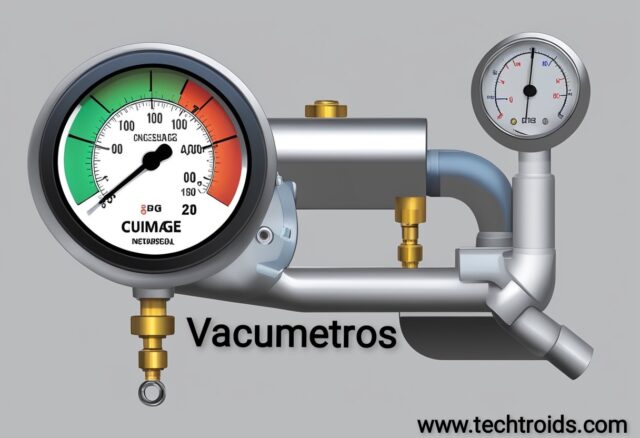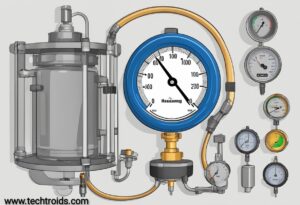Vacumetros: Vacumetros also known as vacuum gauges, are devices that measure and monitor the level of vacuum within a closed system. They are used in various industries, including manufacturing, research, and automotive, to ensure the effectiveness of vacuum systems and prevent equipment failure by identifying leaks or inefficiencies. With their easy-to-read displays and accurate readings, vacumetros are essential tools for maintaining optimal vacuum levels and ensuring precision and efficiency in vacuum processes. A row of vacuum gauges mounted on a control panel, with glowing dials and illuminated indicators.
Vacumetros come in various types, including analog and digital gauges, and can measure vacuum levels ranging from atmospheric pressure to high vacuum levels of 1 x 10^-8 torr or lower. They are typically used in vacuum chambers, pipelines, and other vacuum systems to provide crucial insights into the pressure conditions within these systems. Utilized across industries, vacumetros aid in maintaining optimal vacuum levels for efficient and effective vacuum processes.
Whether you are a researcher, manufacturer, or technician, understanding the basics of vacumetros is crucial to ensuring the success of your vacuum processes. In this article, we will provide you with a comprehensive guide to vacumetros, including their types, applications, and how to choose the right vacumetro for your needs.
Vacuum Gauge Fundamentals
A vacuum gauge is connected to a metal pipe, with numerical readings displayed on the gauge
Types of Vacuum Gauges
Vacuum gauges come in various types, each with its unique features and benefits. The most common types of vacuum gauges are:
Thermocouple Gauges:
These gauges measure vacuum pressure by detecting the temperature of the gas molecules in the vacuum. They are accurate, reliable, and can measure pressures as low as 10^-3 Torr.
Pirani Gauges:
These gauges measure vacuum pressure by detecting the thermal conductivity of the gas molecules in the vacuum. They are simple, inexpensive, and can measure pressures as low as 10^-4 Torr.
Ionization Gauges:
These gauges measure vacuum pressure by detecting the ionization of gas molecules in the vacuum. They are highly sensitive, accurate, and can measure pressures as low as 10^-9 Torr.
Operating Principles
All vacuum gauges work on the same basic principle: measuring the pressure of gas molecules in a vacuum. Depending on the type of gauge, this is accomplished using various methods such as thermal conductivity, ionization, or temperature detection.
To use a vacuum gauge, you must first connect it to the vacuum system you want to measure. Once connected, the gauge will detect the pressure of the gas molecules in the vacuum and display the results on a dial or digital readout.
It’s important to note that different vacuum gauges have different measurement ranges and accuracy levels. Therefore, it’s essential to choose the right gauge for your specific application to ensure accurate and reliable results.
In summary, vacuum gauges are essential tools used to measure and monitor the level of vacuum within a closed system. Understanding the fundamentals of vacuum gauges, including their types and operating principles, is crucial for selecting the right gauge for your application and obtaining accurate results.
Vacumetros Measurement Techniques
A vacuum gauge connected to a chamber, displaying pressure readings. Various measurement tools and equipment surround the setup. When measuring vacuum, there are two primary techniques: direct and indirect measurement. Every method has its good and bad points, and which one to use depends on what you’re trying to do.
Direct Measurement
Direct measurement involves the use of a vacuum gauge to measure the pressure inside a vacuum chamber. There are several types of vacuum gauges, including:
- Mercury manometers
- Bourdon gauges
- Capacitance manometers
- Ionization gauges
Each gauge has its own range and accuracy, and the choice of gauge depends on the pressure range and accuracy required for the application.
Indirect Measurement
Indirect measurement involves the use of other parameters to infer the pressure inside a vacuum chamber. Common indirect measurement techniques include:
Mass spectrometry: measures the mass-to-charge ratio of ions to determine the composition of a gas sample in a vacuum chamber.
Thermal conductivity: measures the thermal conductivity of a gas sample to determine its pressure.
Pirani gauge: measures the thermal conductivity of a gas sample to determine its pressure.
Residual gas analysis: measures the residual gas inside a vacuum chamber to infer the pressure.
Indirect measurement techniques are often used when direct measurement is not possible or when a higher level of accuracy is required. However, indirect measurement techniques are generally less accurate than direct measurement techniques.
In summary, when measuring vacuum, it is important to choose the appropriate measurement technique based on the specific application. Direct measurement techniques offer higher accuracy, while indirect measurement techniques are often more convenient and can be used in situations where direct measurement is not possible.
Vacumetros Gauge Applications
Vacuum gauges, also known as vacumetros, have a wide range of applications in both industrial and scientific settings. Here are some of the most common applications of vacuum gauges:
Industrial Use
In industrial settings, vacuum gauges are used to monitor and maintain pressure levels in various processes. They are especially handy in these fields:
HVAC: Vacuum gauges are used to measure the pressure levels in refrigeration and air conditioning systems. They help ensure that the systems are running efficiently and that there are no leaks.
Semiconductor Manufacturing: Vacuum gauges are essential in the semiconductor industry, where they are used to measure the pressure levels in vacuum chambers during the manufacturing process. This helps ensure that the process is carried out under the correct conditions and that the products are of high quality.
Food Packaging: Vacuum gauges are used to measure the pressure levels in vacuum packaging machines. This helps ensure that the food is packaged correctly and that it stays fresh for longer.
Scientific Research
In scientific research, vacuum gauges are used to measure pressure levels in various experiments and processes. They are particularly useful in the following fields:
Physics: Vacuum gauges are used to measure the pressure levels in vacuum chambers during experiments. This helps ensure that the experiments are carried out under the correct conditions and that the results are accurate.
Chemistry: Vacuum gauges are used to measure the pressure levels in chemical reactions that take place under vacuum. This helps ensure that the reactions are carried out under the correct conditions and that the products are of high quality.
Materials Science: Vacuum gauges are used to measure the pressure levels in vacuum chambers during the manufacturing of materials. This helps ensure that the materials are of high quality and that they have the desired properties.
Overall, vacuum gauges are essential tools in a wide range of industries and scientific fields. They help ensure that processes are carried out under the correct conditions and that products are of high quality.
Installation and Maintenance
Installation Guidelines
When installing a vacuometer, it is important to ensure that it is properly calibrated according to the manufacturer’s recommendations. This will help to ensure accurate readings and prevent equipment failure. Additionally, you should make sure that the vacuometer is installed in a location that is easily accessible and visible to users.
Before installing the vacuometer, you should carefully read the manufacturer’s instructions and ensure that you have all of the necessary tools and equipment. You should also make sure that the vacuometer is compatible with your vacuum system and that it is installed in a location that is free from vibrations and other sources of interference.
Maintenance Best Practices
To ensure that your vacuometer continues to provide accurate readings, it is important to follow proper maintenance procedures. This can include regular calibration, cleaning, and inspection.
Regular calibration is essential to ensure that your vacuometer is providing accurate readings. You should follow the manufacturer’s recommendations for calibration frequency and make sure that you have the necessary equipment to perform the calibration.
Cleaning your vacuometer is also important to ensure accurate readings. You should follow the manufacturer’s instructions for cleaning and use only approved cleaning solutions. Avoid using harsh chemicals or abrasive materials that could damage the vacuometer.
Finally, regular inspection can help to identify any potential issues with your vacuometer before they become major problems. You should inspect your vacuometer regularly for signs of wear and tear, damage, or other issues. If you notice any problems, you should contact the manufacturer or a qualified technician for assistance.
Performance and Calibration
Accuracy and Range
When it comes to performance, vacumetros are known for their accuracy and range. These instruments can measure vacuum levels with precision, providing accurate readings that are essential in various industries. The accuracy of a vacumetro is typically expressed as a percentage of the full scale of the instrument. For instance, if a vacumetro has a full-scale range of 0 to 1000 millibars, and its accuracy is ±1%, then the instrument can measure vacuum levels with an accuracy of ±10 millibars.
The range of a vacumetro refers to the minimum and maximum vacuum levels that it can measure. Some instruments have a narrow range and can only measure vacuum levels within a specific range, while others have a wider range and can measure vacuum levels from atmospheric pressure down to high vacuum levels.
Calibration Procedures
To ensure that a vacumetro provides accurate readings, it must be calibrated regularly. Calibration involves comparing the readings of the instrument with a reference standard and adjusting the instrument if necessary. Calibration procedures may vary depending on the type of vacumetro and the manufacturer’s recommendations.
One common calibration procedure is to use a calibration pump that generates a known vacuum level, which can be compared to the readings of the vacumetro. The instrument can then be adjusted to match the known vacuum level, ensuring that it provides accurate readings.
It’s important to note that calibration procedures should be performed by qualified personnel who have the necessary training and experience. Improper calibration can lead to inaccurate readings, which can have serious consequences in industries where vacuum levels are critical.
Overall, vacumetros are reliable instruments that provide accurate and precise measurements of vacuum levels. With proper calibration and maintenance, these instruments can provide years of dependable service and help ensure the effectiveness and efficiency of vacuum systems.
Frequently Asked Questions
How do vacuometers differ from manometers?
Vacuometers and manometers are tools for checking pressure. However, vacuometers are specifically designed to measure low pressures, typically in the range of 10^-10 to 10^-4 Torr, while manometers are used to measure higher pressures. Vacuometers also rely on ionizing gases within the vacuum system to produce electrical currents that can be measured and correlated to pressure levels, while manometers use a column of liquid to measure pressure.
What applications commonly use vacuometers?
Vacuometers are commonly used in a variety of industries, including semiconductor manufacturing, vacuum coating, and research labs. They are also used in medical applications such as vacuum-assisted wound closure and vacuum-assisted biopsy.
Can vacuometers measure both absolute and gauge pressures?
Yes, vacuometers can measure both absolute and gauge pressures. Absolute pressure is measured compared to a total vacuum, while gauge pressure is measured compared to the pressure of the air around us. Some vacuometers are designed to measure both types of pressure.
What maintenance is required for vacuometers to ensure accurate readings?
To ensure accurate readings, vacuometers should be calibrated regularly and kept clean. They should also be protected from exposure to high temperatures, humidity, and vibration. In addition, the vacuum system should be free from leaks and contaminants that could affect the accuracy of the readings.
What units of measurement do vacuometers typically display?
Vacuometers typically display pressure in units of Torr or millitorr. Some may also display pressure in other units such as Pascal or Bar.
How do temperature variations affect vacuometer readings?
Temperature variations can affect vacuometer readings by causing changes in the ionization of gases within the vacuum system. This can result in fluctuations in the electrical currents measured by the vacuometer. To minimize the effects of temperature variations, vacuometers should be kept in a stable environment and allowed to reach thermal equilibrium before taking readings.









